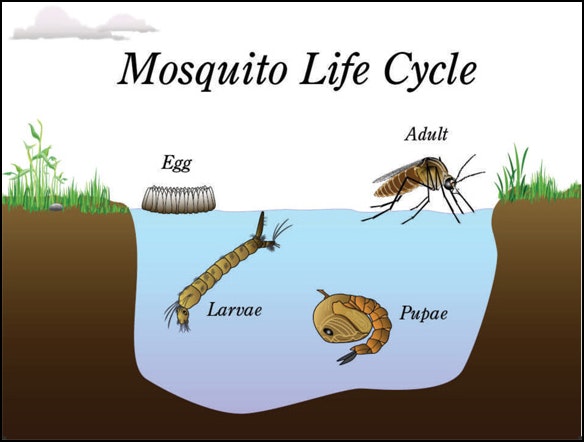Mosquito Life Cycle

Mosquitoes go through 4 different stages in their life. The four stages are egg, larva. pupa and adult.
Mosquito eggs are generally laid on the surface of water or moist soil. Some mosquito species lay their eggs in clusters called rafts. Each raft holds approximately 250 mosquito eggs. Other mosquito species lay their eggs individually. Eggs can hatch in 1 to 5 days.
Larva hatch from Mosquito eggs. They are also known as wigglers since they are worm-like in appearance and wiggle around in the water. Mosquito larvae are aquatic. They require water to live in though out the larva stage. Mosquito larva feed on algae, bacteria and organic debris in the water. Some species stay in the upper portions of the water and filter their food out of the water. Other species actively swim to lower portions of the water and feed off the bottom and wiggle their way back to the surface to breathe. Most species have a breathing tube known as a siphon attached to their tails. The larvas breathe through the siphon like a snorkler uses a snorkel.
Larvae go through 4 instars. At the end of each instar they molt (shed their skin). After the 4th instar (their final molting) they emerge as a pupa. Pupae look very different from larvae. In the pupa phase mosquitoes look like a "fat comma" with ears. They are also known as tumblers since they tumble around in the water at this stage. This stage like the larval requires water. Instead of a siphon pupa have breathing tubes known as trumpets. The Pupa has no mouth and therefore does not eat. Big changes are happening at this stage as the mosquito prepares to emerge as an adult.
Adult Mosquitoes are what emerge from the pupa. The adult mosquito has 3 major body regions: Head, Abdomen, and Thorax. On the head you will find antennae, eyes and a proboscis. Antennae allow the mosquito to hear and smell. The proboscis is a mouth, which is designed for piercing and sucking (like a straw). The long, thin proboscis is often used to suck up flower nectar and blood. Attached to the thorax are 2 wings and 6 slender legs. The abdomen holds the digestive and reproductive organs.
Only the adult female mosquitoes seek a host for a blood meal. The females often find host animals by smelling the Carbon Dioxide they exhale along with smelling body odors and detecting body heat. The females require the blood as a source of protein for their developing eggs. Most, but not all species of mosquitoes require a blood meal for their eggs.
